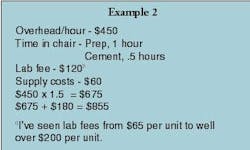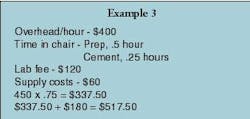The economics of indirect veneers
Edilia Glenski, DMD
If you go to the magazine section of any large book store, you will find at least one health and beauty magazine touting the miracles of today's cosmetic procedures, the king of which is the veneer.
This type of publicity is excellent for raising public awareness about procedures that are much more exciting in terms of personal benefit and that give them an incentive to visit the dentist. Once the patient is in the office, requesting nicer-looking teeth, the dentist has the opportunity to do a comprehensive examination to identify and offer treatment for existing diseases of the head and neck.
Cosmetic dentistry requires a healthy periodontium and sound tooth structure for ultimate success. However, the major ingredient for success is a motivated patient who has a desire to keep his or her teeth for life. We all know this empirically. A patient who has invested good money in improving the appearance of his or her teeth will be far more likely to see the dentist at the recommended recall frequency, have much-improved home care, and will be an advocate for dentistry in general.
The technology that makes indirect veneers possible is revolutionary for our profession. It makes dentistry more sought after by the public. The idea of a "movie star" smile can be enough to make phobics set aside their fears!
Despite the fact that most insurance companies seem to deny payment for veneers, they are not placed solely for cosmetic purposes. Teeth that have been fractured or have large, failed restorations can benefit from veneers. Veneer preparations are the best choice whenever possible because they conserve more natural tooth structure than full crowns. They are preferable whenever clinically feasible for that reason.
Competing in the marketplace
In our competitive marketplace, a dentist who does not offer patients veneers is losing potential customers and revenue. In this day and age when every dentist in the Yellow Pages boasts of providing cosmetic dentistry, a dentist who does not do cosmetic procedures is almost shunned by the public.
Patients who have the discretionary income to invest in cosmetic procedures have done their homework and are quite savvy about what is available. Sometimes, these patients will demand that the dentist perform a specific procedure or use a certain material because they read about it in a magazine or on the Internet. If what the patient wants is inappropriate for his or her treatment, the dentist could be faced with the task of swaying the patient's opinion to an alternate choice that is in this person's best interest. This requires communication skills that usually are not on the average dental school's curriculum.
Another potential roadblock for the dentist is the condition of the patient's dentition. It may be so compromised that correction might require skills that are beyond his or her training.
To meet the increasing demand for continuing education, a number of dental schools and private groups offer both lecture and hands-on courses geared toward the novice, as well as the seasoned veteran. These courses are well-attended, but are sometimes a financial stretch for the average general practitioner.
Fortunately, nonprofit organizations, such as the American Academy of Cosmetic Dentistry, provide excellent lecture and hands-on courses at their annual scientific meetings. These courses are within the reach of most dentists' budgets. The AACD also has a comprehensive and widely acclaimed credentialing protocol for dentists and dental-laboratory personnel who want to excel in cosmetic dentistry.
Pricing
Before the intrusion of insurance companies into our profession, setting fees was simple. All you had to do was charge more than the procedure cost to produce, and you were solvent. Today, fee schedules and "UCR" fees force doctors into unrealistic pricing structures that may be financial folly.
For any business to thrive, the owner must know and be able to control overhead. Overhead calculations for the purpose of setting restorative fees should include all expenses (including payroll) with the exception of lab fees, supply costs, doctor's compensation, and hygiene pay. The total monthly overhead can be converted into hourly overhead by dividing the monthly figure by the number of hours worked per month.
Overhead per hour in a dental office can vary tremendously, depending on the length of time the doctor has been in practice, how much debt load he or she is carrying, what part of the country the practice is in, and the type of décor and equipment selected. A figure of $450 per hour is not uncommon, and I have seen offices that run over $1,000 per hour in overhead. Obviously, the lower the amount, the better.
Calculating what it costs
Once you have calculated your overhead per hour, multiply this figure by how much chairtime it takes to do the procedure, and then add any lab or supply costs. Voilá, you will have your minimum cost for the procedure. Example 2 shows you how to calculate this.
In our example, it takes $855 to produce the veneer. Is that how much this dentist should charge? No! The dentist has not paid his or her salary yet! This dentist needs to charge $1,300 per veneer to make a profit ... or learn to reduce overhead and time in the chair for the patient!
What happens if we speed this dentist up a bit and cut down operating costs? In Example 3, the dentist can charge $963 per veneer and still make the same profit as the doctor in the second example.
Rule of thumb myths
A rule of thumb I have always heard when it comes to setting fees is that you should base your crown and bridge prices at five times the lab fee. Five times our example of $120 would give us a $600 fee, which would allow the dentist in Example 3 to make a small profit, but would be disastrous for the dentist in Example 2.
Another often-quoted rule of thumb is to charge what everyone else is charging! This can be very dangerous, because you have no idea what everyone else is using as a standard for setting their fees. Other dentists could be charging far less than what you need to charge, or the fee could be more than your own skills justify. However, keep in mind that the paying customer does shop prices. Setting fees too high without having a tangibly superior product is professional suicide.
How to lose money on veneers
As you noticed in Example 3, shorter chairtime makes the procedure more profitable. Conversely, longer chairtime can be costly. When it comes to veneers, there are several "chairtime wasters" that can add up to a large loss of income.
The most common chairtime waster is the single anterior veneer. Getting porcelain to match natural teeth on either side is a very challenging task. A perfect match requires numerous photos, records, custom shading at the lab, multiple try-ins, remakes, and repeat visits. Many dentists and patients accept less-than-perfect results on single units; however, compromise does not build word-of-mouth referrals! I deal with the extra time involved by charging double my normal fee because they require twice as much time.
Another time and money-waster is the debonded veneer. Veneers occasionally come off if the occlusion is incorrect, the patient bruxes, or the cement fails. Cement failure can be caused by cementing without obtaining a dry field, operator errors in mixing cement or adhesive, or by a faulty curing light. Laboratory causes for failure come from uneven firing, internal stresses in the porcelain, inadequate etching of the internal surface of the veneer, or contamination of the etched internal surface.
To avoid these pitfalls, ensure that the gingival tissue is healthy and isolate the teeth properly to avoid moisture contamination. Check your curing light intensity frequently and don't skimp on curing time. Also, be sure the assistant who is mixing or dispensing for you is well-acquainted with the materials and that you are watching the materials as they are being mixed. For every patient — including the light or occasional bruxer — adjust the occlusion properly in centric, protrusive, and lateral excursions so that prematurities are eliminated. Then, supply a night guard for added protection. If the patient bruxes severely, it is wise to try some other type of restoration that has a bit more resistance to displacement, as well as fabricating a night guard.
Other than proper prep design, laboratory selection is the other most important factor in veneer success and profitability. A laboratory that can give you a crown or veneer with perfect margins, contacts, and occlusion can save you valuable chairtime. Conversely, margins that are shy, contacts that are too tight or too loose, and occlusion that is off, are the most frustrating waste of time that I can think of.
The "picky" or neurotic patient is the worst offender as far as lost time and revenue and increased stress. Take a cue from plastic surgeons and refuse to treat patients who have unrealistic expectations of what their dental restorations will look like or how a new smile will affect their lives.
The moral of the story is ...
Get your accountant busy figuring out your overhead per hour, cut down on your operating expenses without sacrificing quality, become better and faster at what you do, price your procedures accordingly (keeping in mind what the market will bear), and you'll make all the money you deserve.



